What's On Celebrations | Exhibitions | Biennale | Mostra Cinema
Celebrations Historical Regatta | Redentore | Salute | Vogalonga | Marathon | Marys | St Martin
The Feast of the Madonna la Salute in Venice
La Salute, Great Votive Festival of Autumn
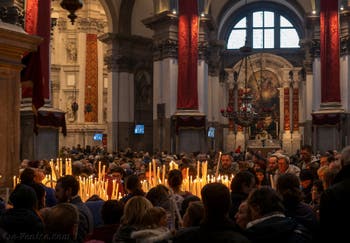
The Venetians at the Feast of the Salute For over three centuries, on November 21, Venetians have made their pilgrimage to the Church of La Salute to pray to the Virgin Mary and give thanks.
As their ancestors have always done since the plague of 1630-1631 ravaged their city, they cross the Grand Canal on a floating bridge that links San Marco directly to the Salute.
Today, the Salute Festival votive bridge crosses the Grand Canal from the Campo del Tragheto (next to the Palazzo Gritti, in the Sestier of San Marco) to arrive opposite, in Calle del Tragheto in the Dorsoduro. A huge crowd crosses it calmly throughout the day, with children's pushchairs and wheelchairs.
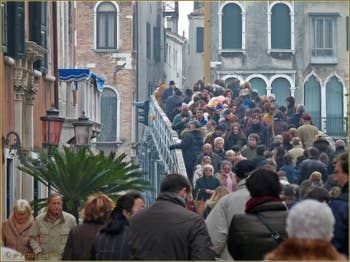
The votive bridge at the Salute Festival Then take the first left to cross Campo San Gregorio.
You then pass under a sotoportego that leads to the Abazia Bridge, at the foot of the Salute.
And here, candle sellers of all sizes are eagerly awaiting the crowds of pilgrims to do their business...
Once the candles have been purchased, the faithful slowly enter the church.

Buying the candles There, since the morning, masses have followed each other continuously throughout the day, and where they will finally be able to light them asking for Our Lady's protection for all those dear to them.
They approach in silence, huddled together, their faces already lit by the light of all the candles burning in front of the altar, each waiting to be able to join their prayers to those of all those who have gone before them by performing the same ritual.
A moment of contemplation that renews the Venetians' deep ties with their past and their religious faith.
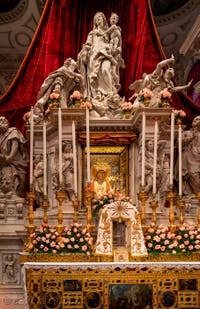
Black Madonna icon Everyone takes part in this rite that links them to their history and their common destiny: the whole of Venice gathers at the Salute, and parades in front of the superb icon of the Black Madonna enthroned above the high altar.
This icon is a 13th-century Byzantine icon brought back from Crete by Francesco Morosini in 1672, shortly after the conquest of Crete by the Turks.
The imposing Church of the Salute dedicated to the Virgin Mary, with its immaculate façade, two campaniles and high dome flanked by a smaller one that can be seen from afar.
In this way, the church was a perfect symbol of grandeur and power, capable of restoring the confidence of the Venetians, who had been sorely tested by the plague and by the struggle to maintain their positions in the East.
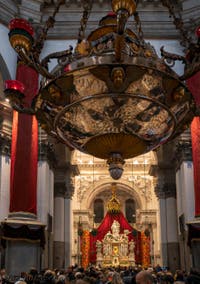
The icon of the Black Madonna of the Salute Grandiosity and new style, here's the new Venice that defeated the plague standing before you!
There's everything for gourmets and children.
Fritelles (little doughnuts) pinocade (aniseed cake with pine nuts), roasted chestnuts, nougats, colourful sweets that look like big salamis, candyfloss...
Venice is full of life as you leave the Salute, crowded with vendors selling all sorts of delicacies to delight young and old alike.
And let's not forget the big helium-filled balloons in all sorts of shapes, a favourite with children, which dominate the crowd of people walking along quietly, laughing and chatting with those they meet on their way home.
La Castradina, Traditional Dish of the Salute Festival
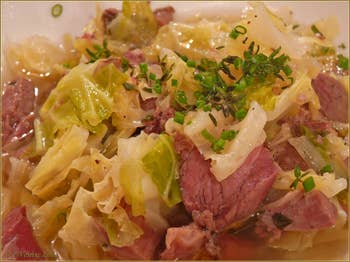
La Castradina, Traditional Dish of the Salute Festival The typical dish of the Salute festival is castradina, an absolutely unique traditional dish made from cured and smoked castrated mutton served with cabbage.
Venetians traditionally eat it on the evening of November 20, the eve of the Salute festival.
The days before, shoulders and legs of dried and smoked mutton can be found on the stalls of butchers, who invite their female customers to shop for castradina.
In fact, the habit of eating castradina is even older than the establishment of the Salute festival, as it is already cited in 1173 during the time of Doge Sebastiano Ziani.
According to some historians, the Albanians were the first to prepare mutton in this very special way, which later spread to Bosnia and Croatia.
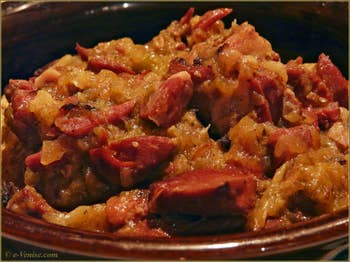
La Castradina, Traditional Dish of the Salute Feast The castrated sheep (no doubt to fatten them up properly) were cut in half lengthways, salted, smoked, dried in the sun, then put under cover to finally mature... before ending up in the holds of the boats that took them to Venice.
The Castradina Imported by Slav sailors from the east coast of the Adriatic.
The sailors from the east coast of the Adriatic who transported castradina, are the origin of the name given to the quay where they docked to sell it to the Venetians: the quai des Slaves or the riva degli Schiavoni, which is still called that!And the very rusticity of castradina, which feeds its man so well that he generally no longer feels the need to go to the table during the long hours that can prove necessary to digest it, nevertheless offers a unique opportunity to rediscover ancient flavours....
This is perhaps why Venetians continue to enjoy castradina with family and friends at the Salute festival.
And they know how to appreciate and enjoy this moment of conviviality, since the popular expression "cavàrsela de castradina" means to have fun, to be entertained.
The Feast of the Salute: The Same Origins as the Feast of the Redentore
The Feast of the Salute is a votive festival linked to the fight against the plague, like the Feast of the Redentore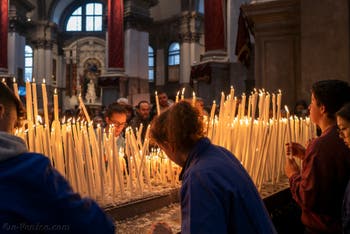
The Venetians at the Feast of the Salute Just as the Doge and the Senate had vowed to build a church dedicated to Christ the Redeemer on the island of Giudecca so that He would deliver it from the plague of 1575-1577, so the plague of 1630-1631 led them this time to turn to the Virgin Mary by building her a beautiful church very close to the Dogana da Mar.
With the same promise to come there once a year to attend a solemn mass, to commemorate this vow and this tragic event in the history of Venice.
On the feast of the Salute, as on that of the Redentore, the Doge and all the people of Venice would come in procession to attend the solemn mass, passing over a bridge of boats specially built for the occasion.

The Feast of the Salute And while the festivities on the night of the Redentore somewhat reduce the number of worshippers at mass the following day, this is not the case for the Feast of the Salute, where whole families flock to pray to the Madonna in front of hundreds of lit candles.
Salute is a difficult word to translate, since it means both health and salvation in the religious sense of the term: the Madonna de la Salute protects the body from illness and the soul from evil.
Her protection is essential if we bear in mind that, in the Christian religion, epidemics were seen as signs of God's wrath punishing men for their sins.
The Contamination Via Trade Exchanges with the East
It was at the Dogana da Mar, the Sea Customs, that ships from all over the Mediterranean basin and the Orient docked to declare the contents of their cargo to the authorities.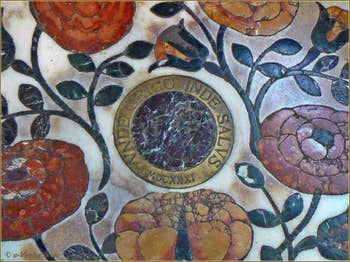
The mosaic pavement of the Salute But they also brought the famous black rats, those dangerous passengers who stowed away by clinging to the mooring ropes... to settle in Venice, and transmit their diseases.
The rats did not transmit the disease directly, but through their fleas.
And when a rat died of a disease such as the plague, the fleas were sure to transmit it to their new hosts, whether man or beast, especially at a time when public health and personal hygiene were far from perfect.
The Contamination caused by the Chaos of War
It should be remembered that the plague of 1575-1577 had been a harsh experience for the Venetians, who had set up the Lazzaretto Nuovo for the occasion, and who had since been in the habit of strictly applying effective preventive measures... unfortunately neglected or ignored by neighbouring countries, especially in times of conflict such as the years around 1630.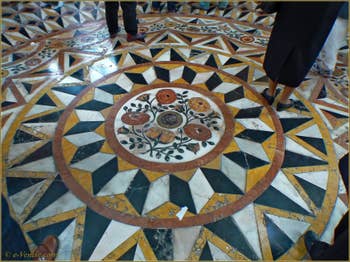
The mosaic pavement of the Salute The Thirty Years' War that ravaged Europe was a sad example of this ; as was the war of succession for the Duchy of Mantua, in which Venice and France supported the Duke of Nevers, whom Vincenzo of Mantua had designated as his successor, against Spain, the Empire and the Duke of Savoy, who supported a Spanish suitor.
Venice's participation in this war ended on 25 May 1630 with the terrible defeat at Valeggio, near Verona.
On 8 June the ambassador from Mantua came to take refuge in Venice, while the city of Mantua, which had been under siege for several months by the troops of emperor Ferdinand and was struggling with hunger and plague, finally surrendered on 18 July.
July 1630: The Plague is in Venice
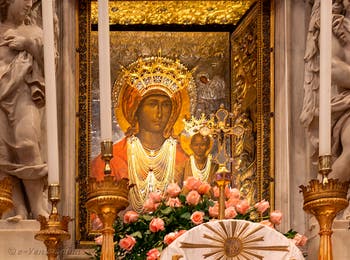
The icon of the Black Madonna of La Salute So much so that in July 1630, through no direct fault of the rats on the ships, the first case of plague broke out in Venice on the Campo Santa Agnese: the carpenter Giovanni Maria Tirinello had been infected on his way to work on the island of San Clemente, where the Duke of Mantua's ambassador and his servants had just died of the plague.
This is the best-known and most widespread version.
But an account written at the time by a physician, Cecilio Fuoli, tells us that as early as the spring 1630, there had already been a debate about the nature of the epidemic that was spreading in Venice.
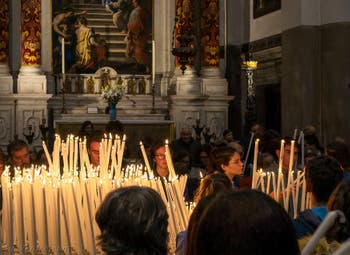
The Venetians at the Feast of the Salute They had summoned 36 doctors, to give their written and signed diagnosis before the notary Benedetto Leoni; and that his uncle the medical officer Giambattista Fuoli, as well as a pharmacist were the only ones to state clearly that it was the plague!
Of the 36 doctors chosen for this consultation, 28 officially stated that there was neither plague nor a suspected case of plague; which, according to the author, revealed an incredible blindness due to professional rivalries, and the primacy of economic interests over the terrible reality of the cases observed daily.
And he relates that the protomedico Giambattista Fuoli, who had argued his thesis with conviction during the session, was reprimanded by a public health inspector advising him: "To be more careful when advancing opinions prejudicial to private and public commerce, to the economy and to the freedom of the Fatherland."
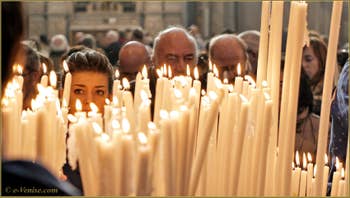
Prayers of the Venetians e-Venice note: The protomedico was a doctor who reported directly to the inspectors responsible for public health in Venice, to whom he gave medical and scientific advice on the health problems they faced. Cecilio and Giambattista Fuoli held this position during and after the plague of 1630-31. This refusal to acknowledge the truth undoubtedly delayed the necessary health precautionary measures that had already proved their worth during the great plague of 1575-1577
And when the people of Venice finally learned that it was the plague, the emotion was such that there were reactions of uncontrolled fear.
The Hunt for the Plague Sowers
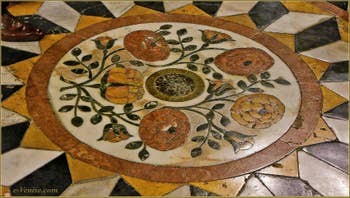
The central mosaic Near the church of Bonaventura, French scientists were accused of being plague sowers because they were in possession of a few ampoules, and were forcibly taken to the health inspectors.
In fact, the ampoules contained only etching fluid, and the accused were chemists!
After such events, On 2 August 1630, the Provveditori alla Sanità (the inspectors responsible for public health) published a statement entitled "Contro gli untori a Venezia".
This declaration "Against the plague sowers in Venice" is set precisely against the backdrop of a climate of suspicion engendered by fear.
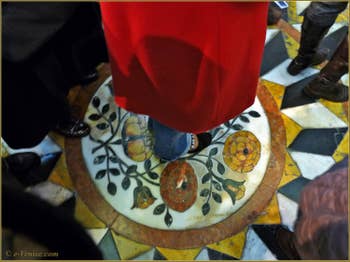
Prayer in the centre of the sacred mosaic The inspectors wanted to calm popular distrust by proclaiming that foreigners residing in Venice would henceforth be required to have a special registration ticket.
And the case of the Untori (plague-spreaders) was raised in these terms:
"In the event that sufficiently perverse persons, wish to deliberately contaminate the city with diabolical intentions by using powders and plasters, the Public Power officially declares, to everyone and everywhere, that they must be arrested, prosecuted and severely punished.
And, when these villains are found guilty, those who denounced them will receive a reward of 500 ducats seized from their property or, failing that, taken from the treasury of the Government"
But Venice had already been contaminated for a long time, and the plague sowers no longer made much difference!
24,000 Panic-stricken Venetians Left their city in August 1630
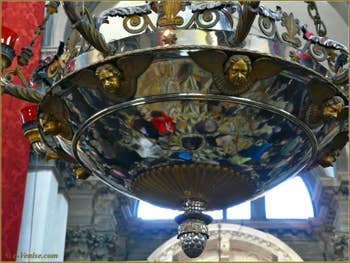
Lustre in the centre of the dome By August the panic was such that nearly 24,000 Venetians had fled the city in a matter of days to take refuge in the countryside, forcing the Republic to react by reminding the nobles of their duty not to desert their offices or magistracies!
For all the measures that had already been taken during the plague of 1575-1577 had to be maintained, all forces had to be assembled and all resources mobilised to deal with this new scourge.
And reason quickly took over, even though there was already an average of 1,000 deaths per month.
The inspectors responsible for public health (the Provveditori) then took important decisions, in anticipation of a resurgence of the epidemic.
How to combat the Plague? Venice Takes Precautionary Measures
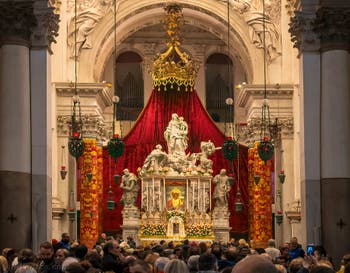
The high altar of the Salute The same methods were used as in 1575 to clean clothes, and disinfect the homes of plague victims: lye, pitch, pine resin, juniper or bay berries, gunpowder, myrrh, styrax...
Others proposed radical measures, such as eliminating pigeons, which they considered to be the most affected and therefore the biggest vectors of the disease.
Using quicklime
On October 12, 1630, the Senate announced to the city of Treviso that it must regularly supply Venice with two barges of quicklime per week, because the barges loaded with corpses were getting stuck in Venice because of the headwinds that prevented them from reaching the lido island, and the health problems caused by this congestion were becoming such, that the doctors decided that the barges had to be filled with quicklime and a canal filled with sand.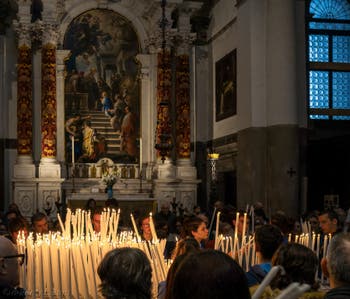
The Venetians at the Feast of the Salute Nobles could still be buried in churches, but the body had to be enclosed in a leaded sarcophagus and covered with quicklime.
Arsenal Workers to Make Beds for Hospitals
On 26 October, the Provveditori of Health ordered the Arsenal to manufacture 1,000 beds for the Lazzaretti.Three days later the order was increased to 2,000, in anticipation of the explosion in the number of patients.
Mortality actually reached 2,120 deaths in October.
The Arsenaletti, the workers of the Arsenal, were specialised in all the trades related to shipbuilding.
They were therefore of strategic importance to the Maritime Republic, so much so that the Senate was concerned about their health and wanted to take special measures to protect them.
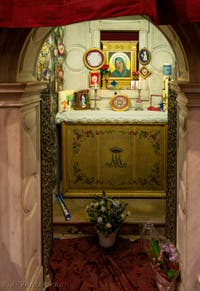
Ex- voto and offeringsWhen Venice counted 595 victims in the only day of 9 November, it became urgent to find ways of trying to limit this slaughter, particularly in the ranks of the Arsenaletti!
The Cloistered Workers in their Arsenal
On December 14, the Senate decided that sick workers should be treated at the Lazzaretto Vecchio in rooms reserved for them, and separated from the other sick.Suspect cases could be treated at home, but care would be taken to place them in uncontaminated accommodation, while some of the healthy workers would remain locked up in the Arsenale, totally isolated from the rest of the town.
And on December 16, he asked the workers remaining outside to return to work, guaranteeing that the Arsenal would be rigorously grilled to protect the health of "this much-loved category of men whom we value so highly, also for our service".
The brave Arsenaletti remained locked up in this way until February 20 of the following year, when they were finally allowed to rejoin their families!
Despite all these precautions to protect this precious workforce, by the end of the epidemic there were only 600 survivors out of a total of 1,500 workers.
A Peak in Mortality in November 1630 with 14465 Deaths!
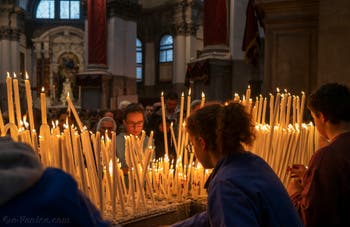
The Venetians at the Feast of the Salute The Arsenal was ordered to make special carts to transport the corpses, as well as around fifty ferries to be able to transport them to the Lido.
Before burying them, the undertakers stripped the corpses of their clothes, which were then immediately burnt.
Doctors and undertakers protected themselves by wearing tarred gloves, gowns and masks. In addition, lime was used to disinfect the walls of plague victims' homes and to cover their corpses before burial.
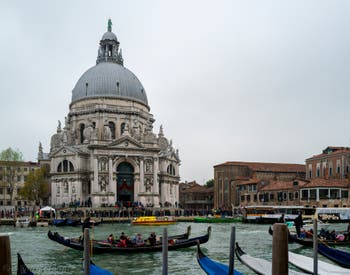
The church of the Madonna of the Salute On November 2, the Senate conceded freedom to prisoners at the end of their sentences, or considered not very dangerous, if they were prepared to do the dangerous job of undertaker.
Because of the lack of applicants and the high mortality rate at the time, as early as November 15 the Senate promised 20 ducats a month to undertakers.
Two people were hanged for disobeying the precautionary instructions ordered by the health inspectors.
Others were punished in the same way for looting, but this was mainly because they had stolen furniture that had been declared infected and therefore susceptible to contamination...
Despite all these efforts, Venice still had 7,641 deaths in December alone.
A Land Tax and a Loan of 10,000 Ducats to Meet Plague Expenses

After the prayers, the candyfloss! The care given to the sick in the Lazzaretti, and all the measures taken to deal with the scourge were expensive.
And as it had already done during the pague of 1575-1577 to replenish the Republic's coffers, on 16 October 1630 the Senate passed additional time-limited taxes, paid by owners of rented accommodation.
One grosso per ducat had to be paid for rents between 20 and 40 ducats, and two grosi per ducat in the bracket above 40 ducats.
And on the same day, the Senate requested a borrowing of 10,000 ducats from the Jews of Venice.
But many remained convinced that the plague was a divine punishment, like Nicolò Contarini who had been elected doge for six months...
Venice decides to Build the Church of the Madona de la Salute, dedicated to the Virgin Mary praying to her to put an end to the epidemic
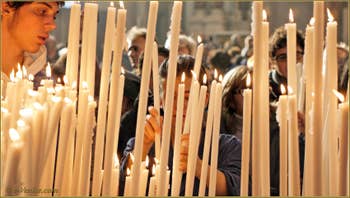
Hundreds of candles lighting up the church As early as 22 October, a debate in the Senate led to the decision to dedicate a church to the Virgin Mary, so that she would deliver Venice from the plague.
With the addition of the promise of an annual visit from the Doge, who would solemnly come to renew her request to protect Venice, and who would show her all his respect.
It was at St. Mark's Basilica that the Doge Nicolò Contarini officially announced the construction of a votive church, to be called Chiesa della Salute.
It was to be both original and prestigious.
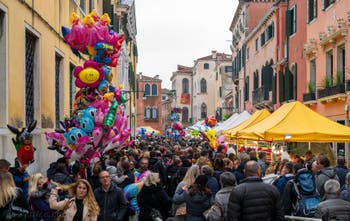
Balls and sweets for the little Venetians at the Madonna della Salute festival in Venice So that the best architects could present their projects, Venice shared its decision with foreign ambassadors.
Eleven competitors presented their projects; three were retained after an initial selection, finally choosing a young architect full of new ideas: Baldassare Longhena.
As early as January 1631, work began on demolishing the old Trinity Hospice at the entrance to the Grand Canal, in preparation for the foundations of the Salute.
New Peak in Mortality in March with the Sirocco and the Laying of the First Stone of the Salute is Postponed
There was a new peak in mortality in March 1631 with the sirocco (south wind).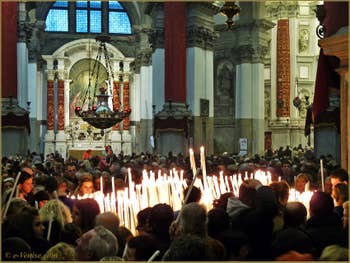
The church of the Madona de la Salute And the laying of the foundation stone of the Church of the Salute, which was due to take place on March 25, the anniversary of Venice and St. Mark's Day, was also postponed because the Doge was ill, but not with the plague.
On April 1, 1631, the Doge Nicolò Contarini laid the first stone of the Salute. The next day, he was dead!
The new doge Francesco Erizzo was elected on April 10, but there were no celebrations, for fear of contagion.
This terrible plague finally stopped in November, and the government of the Republic wanted to keep its promise.
They didn't want to wait until construction of the future Church of the Salute was complete to show their gratitude to the Madonna.
On November 21, The Feast of the Madonna la Salute in Venice
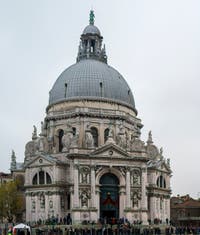
The church of the Salute
28 November 1631: First Feast of the Salute
The November 21, the day of the presentation of the Virgin Mary in the Temple, had already been chosen; and as there was no church yet, the Venetians managed to build a large temporary wooden church in four days!A bridge of boats was also installed so that the procession could cross the large canal separating San Marco from the tip of the Dorsoduro.
As soon as all this was completed, the first Salute festival was held this time on November 28 instead of November 21.
End of the Plague in November 1631: Venice lost a third of its Population
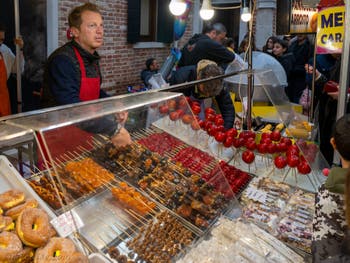
Balls and sweets for the little Venetians at the Madonna della Salute festival in Venice. The epidemic was officially declared over in November 1631, after killing a third of the population: between 46,490 and 51,903 people died in the city and in the Lazzaretti.
Adding Murano, Chioggia, Malamocco, and the Jews in the ghetto, the figure fluctuates between 82,175 and 93,661 victims.
The figures vary according to the sources (public health inspectors and Dr Cecilio Fuoli), and according to whether or not the islands in the lagoon are taken into account, or certain social categories such as monks, nuns and Jews.
But they are nonetheless impressive and dramatic.
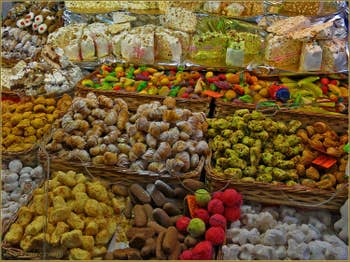
Sweets for young and old At the 1633 census, after encouraging the immigration of skilled people from neighbouring lands, Venice had only 102243 inhabitants, compared with 142,804 before the plague.
And it had only 1,660 Nobles left, compared with 2,500 in the middle of the previous century.
Thankfully, this was the last plague epidemic in Venice's history, and she was to regain the upper hand and show everyone that she was still as powerful as ever.
By building the Salute, the city gave new courage to those who survived, and wanted to show its new-found dynamism with one of its most recognisable and prestigious buildings.
Celebrations Historical Regatta | Redentore | Salute | Vogalonga | Marathon | Marys | St Martin
What's On Celebrations | Exhibitions | Biennale | Mostra Cinema
Back to Top of Page

